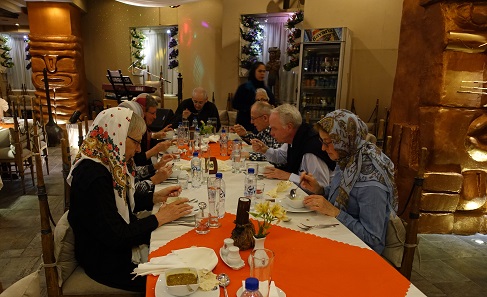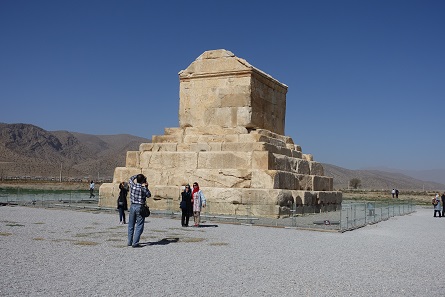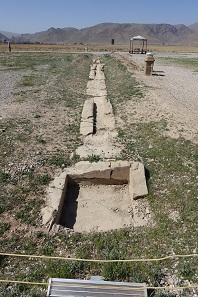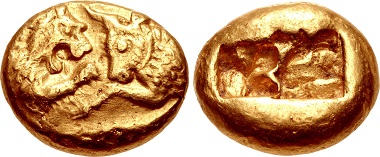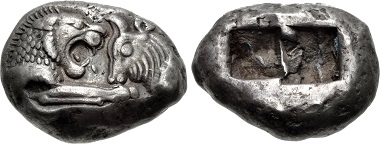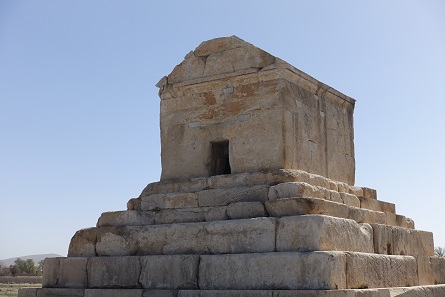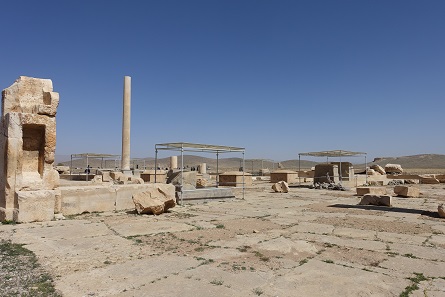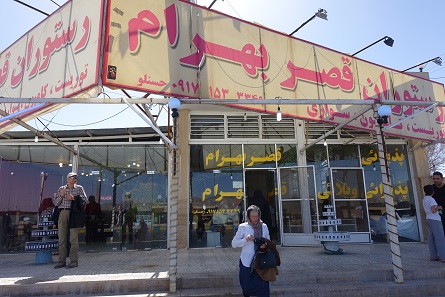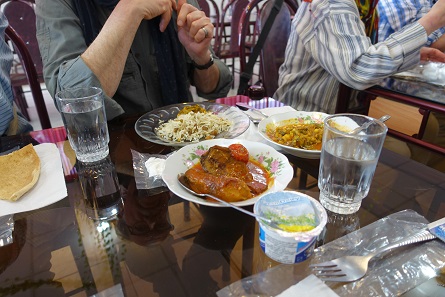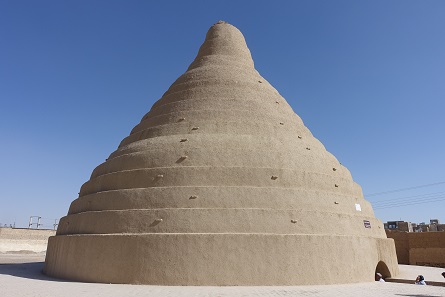by Ursula Kampmann
translated by Teresa Teklic
February 9, 2017 – Do you belong to the disappearing minority of people who had to suffer through learning Ancient Greek? At least it has enabled me visit restaurants in modern-day Greece and impress the waiters by reading the menu in the local language and ordering without being too surprised when the food arrives at the table. Three semesters of language classes which ended with the “Graecum” (the standard qualification in Ancient Greek in Germany) and, unfortunately, left me with a personal antipathy towards Xenophon, who did not only write the Anabasis but also the Cyropaedia. Especially the Cyropaedia haunted me in my nightmares. Since we didn’t work with it in class, the texts were bound to appear in the exams. That was somewhat of a downer for my relationship with Cyrus II, whose education is described in the Cyropaedia and whose tomb we visit in this episode of the numismatic diary.
A glimpse of the international restaurant of the Pars Hotel: Notice the Easter Islandish looking columns in the background and the famous roux à l’Iranienne, a condiment that our Iranian guide did not want to go without even in this exotic restaurant. Photo: KW.
Thursday, 17 March 2016
International hotels abroad are simply fantastic! They show us how foreign cultures are perceived by the locals. So did the hotel we were staying in, Hotel Pars. It offered an exotic cuisine or rather what counts as exotic cuisine in Iran these days. The menu comprised, among others, Mexican chicken (with extra paprika) and Japanese kebab (made from mutton and marinated in plum juice). Not that I have ever eaten such chicken in Mexico or seen such lamb kebab in Japan (do they even eat lamb kebab in Japan?) but after all the German Toast Hawaii from the 1970s also got its name from nothing but the single slice of pineapple…
The tomb of Cyrus the Great is a popular destination for Iranians too, especially on Newroz. Photo: KW.
Anyhow, we took off at 7.30 am on Thursday in anticipation of the long drive to Pasargadae. And what a hustle and bustle it was! A shopping street was set up to satisfy all wishes of the local tourists when visiting the Tomb of Cyrus on Newroz. You almost wouldn’t believe that all those booths, fast food stalls, and souvenir shops are set up only for the short days around the New Year. Plus, an additional line of toilets had been set up. We even saw a staircase out of steel being assembled from a kit so that visitors would be able to reach the book shop which had been set up on a small, elevated plateau. Everywhere busy hands were engaged in timbering and construction works. At some point a helicopter landed just to show all those present that the police was in place to do its duty. Someone got off, walked around the tomb of Cyrus, got back in and took off again.
Great reception hall in which Cyrus II impressed his visitors. Photo: KW.
Pasargadae was the first capital of the Persian Empire, although little of it remains. Something you notice all the more if you have visited Persepolis the previous day. Cyrus II is regarded as its founder. Diverse sources, some contemporary, keep us relatively well informed about him.
Aqueduct in Pasargadae. Photo: KW.
He is said to be a son of Cambyses I and a grandson of Cyrus I. He certainly was not related to Darius I and his descendants. A common ancestor by the name of Achaimenes, name-patron to the Achaemenids, is a neat political invention of Darius. Meaning that, when we refer to the Persians as Achaemenids, we are still buying into the wilful misrepresentation of history by a usurper. And here a handful of journalists talk of living in the postfactual age just because of one Donald Trump? Those in power have always lied like troopers. That is neither new nor creative. Just remember our own recent experiences with the German Cultural Property Protection Act.
Countless legends exist about the youth of Cyrus – so an evil king is said to have attempted a child murder in the line of the Bethlehem Massacre of the Innocents, and have him and all other new-born children killed. Verified information, however, is rare. It only sets in with the fall of Astyages, ruler over the Medes. It is said that Cyrus founded his new capital at the location of the decisive battle.
Croesus. Stater, heavy series. Prototype. From CNG sale, Triton XVIII (2015), 656.
Then Cyrus set off to new conquests. The coast of Asia Minor formed a natural border and so he sent his messengers to Croesus, King of Lydia, who at the time controlled many Greek cities. We all know the story of Croesus’ reaction, who left the decision on how to proceed to the Oracle of Delphi. Not such a good idea. Shortly after, probably in 541 BC, his capital Sardis was taken. The historical records do not offer a unified account of what happened to Croesus after that; what happened to his currency, however, numismatists know very well.
Croesus. Stater. From CNG sale, Triton XVIII (2015), 662.
Cyrus and his successors continued to mint the gold and silver staters of Croesus. They didn’t need coins for domestic trade though. The staters were meant as currency for the Greek part of the empire, especially to pay the highly sought-after Greek mercenaries. Mercenaries always came in handy, there were plenty of wars in the years to come. Many cities in Asia Minor did not surrender to the Persians without putting up a fight. (And never in their history have Greek mercenaries had a problem with fighting Greeks from other cities.) Plus, Cyrus was constantly expanding his empire. In 539 he conquered Babylon.
Cyrus died in August in 530, probably in battle against a nomad tribe at the eastern border. It is very well possible that he was fighting the Massageteans, as Herodotus reports. Anyway, his body is said to have been brought back to Pasargadae to be buried there.
Entrance to the Tomb of Cyrus. Photo: KW.
We know some ancient descriptions of his tomb. Arian and Strabo have left their impressions to posterity, and their accounts do not even differ that much. They say a magnificent garden surrounded the edifice. That there was a golden sarcophagus and a table topped with precious glass vessels in the accessible burial chamber. A Persian inscription is said to have adorned the tomb: O man, whoever thou art, from wheresoever thou cometh, for I know you shall come, I am Cyrus, who founded the Persian Empire. Grudge me not, therefore, this little earth that covers my body.
Even without the inscription and the golden sarcophagus, the simple tomb construction of the founder of the Persian Empire is pretty impressive. Perhaps it is its very simplicity that is so striking. Contemporary scholarship assumes that this particular kind of tomb was adopted from the Lydians. Why not? The Persians seem quite fond of copying other people’s good ideas. See for instance fig. 6.
Not an awful lot has been left over from the ancient capital Pasargadae. Photo: KW.
And on we went to the former palace of Pasargadae. Honestly, we kind of had a hard time paying the necessary respect to the bits and pieces of leftover walls and architecture. We did our duty by strolling down the path from the so-called private palace to the reception palace and to the gate – which features an interesting figure wearing what is without doubt an Egyptian crown, but none of us was really enthusiastic about the whole thing.
One of the few restaurants in Iran able to feed a whole group of people. Photo: KW.
And once more we got on the bus. Destination: Yazd. A bit less than a five-hour drive. The only break we took was lunch break. Because, for once, there was a restaurant on our route large enough to accommodate all of us. Not many restaurants are that luxurious. And groups of tourists seem to be somewhat out of the ordinary here. At least we were attraction enough for the waiter to take a quick picture of us on his phone. I wonder if that has found its way into the Iranian Facebook yet.
Two things you cannot avoid when dining in Iran: yoghurt and water served with your food. Photo: KW.
A young man with an extravagant hairstyle (lots of hairspray, the hair a little longer than usual, and with a white highlight) took care of us. He spoke a little English and was very capable – in a good half an hour he had fed the whole team, with soup, a main course, and of course tons of rice. This is one thing I’ve noticed: restaurants are always really well prepared for arriving guests. The soup is on the table in no time (soup is essential and a must-serve in Iran, even for breakfast), followed by salad and yoghurt (yoghurt, another must-serve). The main course usually consists of meat (hard times for vegetarians!). The only question is whether they will serve it as kebab, grilled, or stew. Most of the time it’s mutton, but chicken is also in high demand these days. Dessert? Not so much. If there is any, it’s usually jell-o in toxic colours. And that even though Iran is famous for its pastry!
An impressive “icehouse” in Abarkuh in its characteristic form (although you might want to rethink putting it on Facebook). Photo: KW.
On our way to Yazd we passed Abarkuh. There are many ruins of formerly grand bourgeois palaces made of clay. Unfortunately they are slowly decaying. Nobody is making an effort to preserve them. Still, one icehouse has been completely restored with a considerable amount of effort. Up until the 1950s, this fascinating construction was used to store ice in the winter and keep it frozen during the whole summer to cool a variety of things. In the south, east, and west the icehouse was surrounded by walls high enough so that the icehouse was never exposed to direct sunshine.
This is a good time to take a break so that our story doesn’t get too long here. Read about the Towers of Silence and the famous fire temple of Yazd in the next episode of the Iranian travelogue. We will also tell you about a Shiite tradition which strongly resembles the mourning ritual of the Christians on Sicily and Sardinia on Good Friday.
You can find all episodes of my Iranian travelogue here.



